新目标英语七年级下Unit 1 Section A- Period 2
人教新目标版 七年级英语下册 Unit 2 课前+课后同步练习习题 单元合集(含答案)
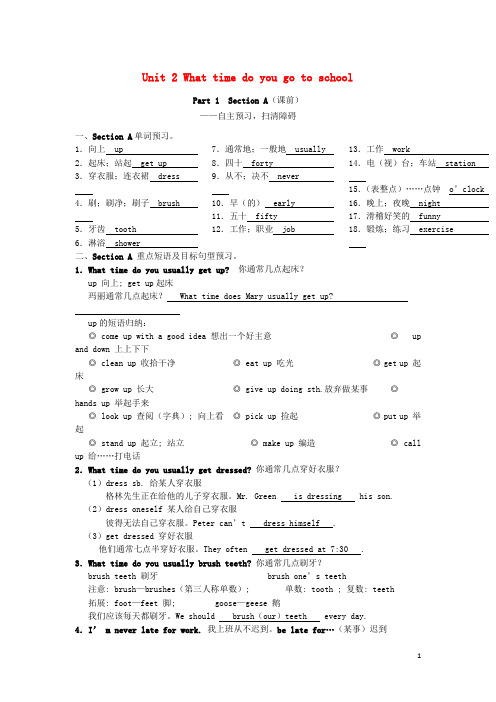
Unit 2 What time do you go to schoolPart 1 Section A(课前)——自主预习,扫清障碍一、Section A单词预习。
1.向上 up2.起床;站起 get up 3.穿衣服;连衣裙 dress4.刷;刷净;刷子 brush5.牙齿 tooth6.淋浴 shower 7.通常地;一般地 usually8.四十 forty9.从不;决不 never10.早(的) early11.五十 fifty12.工作;职业 job13.工作 work14.电(视)台;车站 station15.(表整点)……点钟o’clock16.晚上;夜晚 night17.滑稽好笑的 funny18.锻炼;练习 exercise二、Section A重点短语及目标句型预习。
1.What time do you usually get up? 你通常几点起床?up 向上; get up起床玛丽通常几点起床? What time does Mary usually get up?up的短语归纳:◎ come up with a good idea 想出一个好主意◎ up and down 上上下下◎ clean up 收拾干净◎ eat up 吃光◎ get up 起床◎ grow up 长大◎ give up doing sth.放弃做某事◎ hands up 举起手来◎ look up 查阅(字典); 向上看◎ pick up 捡起◎ put up 举起◎ stand up 起立; 站立◎ make up 编造◎ call up 给……打电话2.What time do you usually get dressed?你通常几点穿好衣服?(1)dress sb. 给某人穿衣服格林先生正在给他的儿子穿衣服。
Mr. Green is dressing his son.(2)dress oneself 某人给自己穿衣服彼得无法自己穿衣服。
2014年秋新目标七年级英语 unit1 what's your name
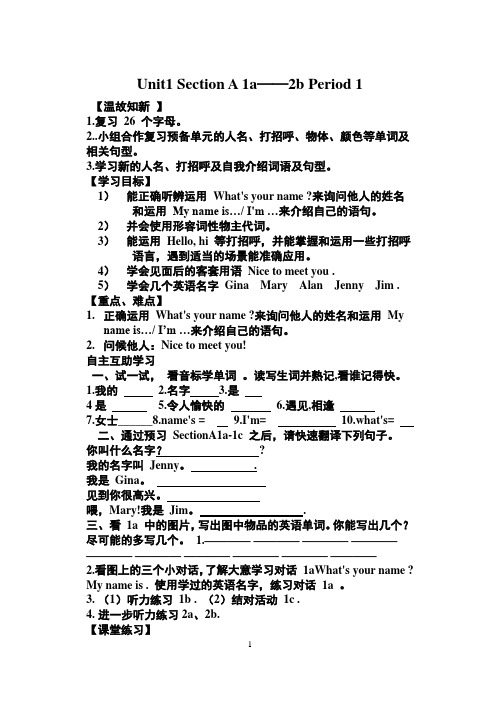
Unit1 Section A 1a——2b Period 1【温故知新】1.复习26 个字母。
2..小组合作复习预备单元的人名、打招呼、物体、颜色等单词及相关句型。
3.学习新的人名、打招呼及自我介绍词语及句型。
【学习目标】1)能正确听辨运用What's your name ?来询问他人的姓名和运用My name is…/ I'm …来介绍自己的语句。
2)并会使用形容词性物主代词。
3)能运用Hello, hi 等打招呼,并能掌握和运用一些打招呼语言,遇到适当的场景能准确应用。
4)学会见面后的客套用语Nice to meet you .5)学会几个英语名字Gina Mary Alan Jenny Jim . 【重点、难点】1.正确运用What's your name ?来询问他人的姓名和运用Myname is…/ I’m …来介绍自己的语句。
2.问候他人:Nice to meet you!自主互助学习一、试一试,看音标学单词。
读写生词并熟记,看谁记得快。
1.我的2.名字3.是4是 5.令人愉快的 6.遇见,相逢7.女士______'s = 9.I'm= 10.what's=二、通过预习SectionA1a-1c 之后,请快速翻译下列句子。
你叫什么名字??我的名字叫Jenny。
.我是Gina。
见到你很高兴。
喂,Mary!我是Jim。
.三、看1a 中的图片,写出图中物品的英语单词。
你能写出几个?尽可能的多写几个。
1.————————————————————————————————————————2.看图上的三个小对话,了解大意学习对话1aWhat's your name ? My name is . 使用学过的英语名字,练习对话1a 。
3.(1)听力练习1b . (2)结对活动1c .4.进一步听力练习2a、2b.【课堂练习】1.写出下列单词。
人教版新目标英语七年级下册unit2全单元教案

Unit 2 Where is the post office?Language goals:●In this unit students learn to talk about asking for and give directions on thestreet.New languages:●Excuse me, is there a bank near here?●Y es, there is. It’s on Center Street.●Where is the pay phone?●It’s across from / next to / in front of / behind the library.●It’s between the post office and the library.●Just go straight and turn left.●Turn left on First Avenue.●T ake a walk through the park on Center Avenue.●There is a clean / dirty park near my house.Difficult points:1. Listening for the information of the names of the neighborhoodRead the tour guide and an e-mail from a friend you’re going to visit.Write the dialogues about asking the way and giving directions.2. Where questions.Affirmative statementsPrepositions of placeTeaching aids:● A tape recorder●Some picturesTeaching periods:Period 1: Section A1a, 1b, 1cPeriod 2: Section A2a, 2b, 2cPeriod 3: Section A3a, 3b, 4Period 4: Section B 1a, 1b, 1c, 2a, 2b, 2cPeriod 5: Section B 3a, 3b, 3c, 4Period 6: Self CheckTeaching aims:1. T each vocabulary words.2. T arget languages: Is there a bank near here? Y es, there is. It’s on CenterStreet.3. Enable the students to ask for and give directions on the street.4. Help the students to ask for and give directions on the street.Teaching procedures:Step 1. Warming upShow three pictures prepared before class to the students. There is acat in a box in picture 1. There is a cat on a box in picture 2. There is acat under the box in picture 3.Then ask some students to ask and answer these questions.Step 2.Match work (2a)Ask the students to read the picture and the words in the numbered list.Ask the students to match each word or phrase on the list with one of the pictures.Then check the answers.Present the new sentence patterns.Then ask the students to read the dialogue in the picture.Step 3. Listening (1b)Ask the students to listen to the conversations and circle the places in 1a.Change the roles and do the same again.Then students ask and answer without the help of the recording.Step 4. PracticePoint to the different locations shown in the picture. Ask different students to name each one.Then point to more locations and let the students to practice more.Homework1. Practice the conversation in the picture on page 7.2. Learn the new words and phrases in this period by heart.Teaching aims:1. Learn the vocabulary words and useful expressions.2. T arget languages:The pay phone is across from the library.The pay phone is next to the library.The pay phone is between the post office and the library.The pay phone is on Greet Street.The pay phone is in front of the library.The pay phone is behind the library.3. Enable the students to talk about the position of a place.4. Help the students to talk about the position of a place.Teaching procedures:Step 1. Revision and warming upCheck the homework by talking about the pictures on page 7 with thestudents or prepare some other pictures with different buildings in itand let the students practice asking and answering questions aboutthe places.Ask the students to practice more.Step 2. Presentation (2a)Introduce the items across from, next to, between, in front of, behindand on.Draw the following picture on the blackboard.Park 3 Centre StreetEncourage or help the students to answer: It’s across from the library.The same way goes with next to, on and in front of.Ask the students to match each sentence with one of the pictures.Then ask the students to read the six sentences and match thesentences the pictures.Check the answers.Step 3. Listening(2b)Review the buildings and street names in Activity 1a and the sixsentences in 2a.The read the six sentences in 2b to the class.Ask the students to listen to the recording and fill in the blanks.Play the tape. Check the answers.Step 4. Practice (2c)Ask the students to repeat the conversations after the recording.Ask the students to do the Pair work asking and answering questionsabout the places in 1a.Step 5.Grammar FocusAsk the students to read the sentences in the grammar box aloud. Theask them to answer the following questions. Explain some languagepoints if t he students can’t understand.HomeworkAsk the students to practice talking about their neighborhood in pairs.Period 3T eaching aims:1. T each vocabulary words.2. T arget languages:Just go straight and turn left.It’s down Bridge Street on the right.It’s next to a supermarket.3. Enable the students to talk about the neighborhood.4. Help the students to talk about the neighborhood.Teaching procedures:Step 1. RevisionLet the students look at the picture in activity 1a. And ask somestudents to answer some questions in order to check the homework.Say, Is there a library near here? Where is it? Is there a bank near here?Where is it?Put up the picture of activity 2a on the blackboard and ask them tomake conversations.Step 2. Presentation (3a)Guide the students to guess the meanings of the three traffic signs.Show the pictures and ask some questions about the pictures.Then ask the students to hold up their left hands and then their righthands to practice “left” and “right”.Point to the picture and let the students read the conversation.Ask the students to read the conversations. Then ask them to find Pauland Nancy in the picture.Ask the students to role play the conversation then point out the placethat Paul wants to get to.Step 3. Complete the conversations (3b)Ask the students to make conversations and answer the questionsbelow each picture.The students point out the place in the picture. And write down theanswers on the line in the pictures. Or ask a pair of students to say theconversation, the others point to the speakers’ place.Step 4. GameAsk the students to look at the picture in Activity 1a and name all the buildings.Ask some students to read the conversation in the picture in Activity 4.And then explain the instruction to the student.Then ask some groups to present their work.HomeworkAsk the students to make a similar conversation to that in Activity 3a. Period 4Teaching aims:1. T each vocabulary words.2. T arget languages:Is there a big supermarket near your house?Y es, there is.There is a big supermarket.No! There is a small supermarket.3. Enable the students to describe the neighborhood.4. Help the students to describe the neighborhood.Teaching procedures:Step 1. RevisionCheck the homework by asking the following questions.Say, Look at the picture in activity 3a. Suppose you are standing nearthe building on the side of New Street. Please answer my questions.Excuse me. Is there a pay phone in the neighborhood?Ask another student to answer questions.Give more students chances to practice this dialogue.Step 2.Match work (1a)Bring in some objects or pictures to the students. (Two rulers, one is old,the other is new. Two boxes, one is big and the other is small. Two bottles, one is clean and the other is dirty. Two pictures of a street, one is busy and the other is quiet.)Say, Look at the rulers, please. Can you find the difference between them? Y es. This one is old. (Show the old ruler.) And this one is new.(Show the new ruler.) Do you understand old and new?Ask the students to talk about the picture.Point to each half of each picture and ask about the difference between the halves.Go on with the other pictures to teach the language items.Ask the students to match the words with the pictures.Step 3. Pair workCall attention to the conversation in the picture.Then ask the students to work in pairs and take turns asking each other questions about the things on the list of phrases in activity 1a on page 7. Step 4. Listening (2a, 2b)Ask the students to listen to the tape and circle the places in 1a.Say: Now please listen to the tape again. Listen to it and draw the places in Michael’s neighborhood on the street map. Just listen.Play the recording.Play the recording again.Then have some students show their completed drawing to the class. Step 5. Pair workAsk the students to work in pairs talking about drawings to the class.Then ask some pairs to present their dialogues to the class.Ask the students to work in pairs, draw a map of their own neighborhood and practice asking and answering questions about the places they live in.HomeworkAsk the students to make similar conversations to that in Activity 1b.Period 5Teaching aims:1. T each vocabulary words.2. T arget languages:Turn left on First Avenue and enjoy the city’s quiet streets and small parks.T ake a walk through the park on Center Avenue.This is the beginning of the garden tour.Bridge is a good place to have fun.3. Enable the students to write a tour guide and draw the rout to somewhere.4. How to write a tour guide and draw the rout to somewhere.Teaching procedures:Step 1. RevisionCheck the homework by asking about the student’s neighborhood.Ask the students to work in pairs.Ask the students to work in pairs.Then ask some pairs to present their conversations to the whole class.Step 2. Reading (3a, 3b)Ask the students to read the tour guide.Divide the whole class into four groups to have a quiz.T ell the students to keep these words down and make at least two sentences with each word after class.After that ask the students to look at the pictures and fill in the blanks for this tour guide.Step 3.WritingAsk the students to write a tour guide with the students.Names of buildings and locations.Description wordsWords that talk about positions.Words that talk about directions.Step 4. Pair work (4b)Learn to draw a picture of neighborhood. First ask the students toanswer the questions according to the pictures.Then ask the students to draw a picture according to the followingconversation.Then ask students to present their drawings to the whole class.Homework1. Ask the students to talk about the street and buildings in their ownneighborhood.2. Ask the students to make sentences with the description words they keptdown in the class.Period 6Teaching aims1. T each vocabulary words.2. T arget languages:I know you are arriving next Sunday.Let me tell you the way to my house.I hope you have a good trip.3. Enable the students to write about the neighborhood.4. Help the students to learn how to write about the neighborhood.Teaching procedures:Step 1. RevisionCheck the homework by asking and answering some questions.Give more students chances to practice.Step 2.Key word check(1)Ask the students to check the words they know.Then ask the students to do the some exercises.Step 3.Vocab-Builders (2)Expand the students’ vocabulary.After that ask the students to share their list with other students.Step 4. ReadingAsk the students to read the letter and draw the rout on the map.Ask the students to change the letter into a telephone conversation.Let the students pay attention to the pictures.Say, Look at the picture of Sally. How old do you think she is? Where do you think she is from? What language do you think she speaks? What do you think she likes?What do you think she dislikes?The same step goes with Jim and Julie.After a few minutes, ask some students to read their descriptions to the class.Step 5. Just for Fun!Call attention to the conversation in the cartoons.Ask the students to read the conversation and then answer the questions.HomeworkAsk the students to do the following:1. Suppose your friend is going to visit you. He doesn’t know the way toyour house. Write a letter to him to tell him the route from the bus stop to your house.2. Review the next unit.。
新目标英语七年级下Unit1 知识点13年新版
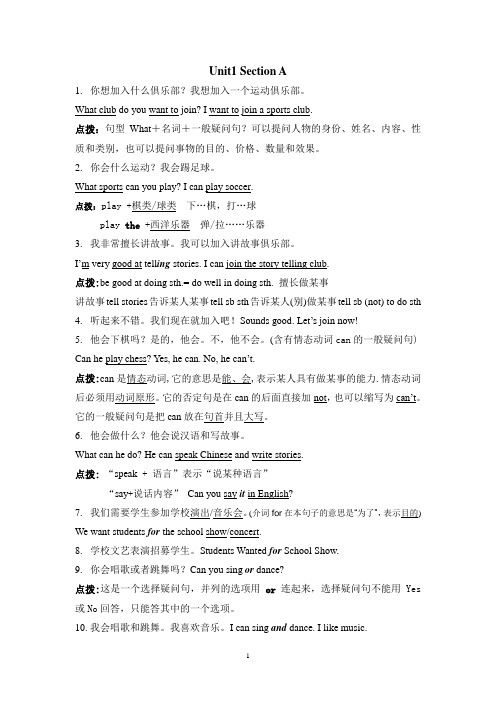
Unit1 Section A1.你想加入什么俱乐部?我想加入一个运动俱乐部。
What club do you want to join? I want to join a sports club.点拨:句型What+名词+一般疑问句?可以提问人物的身份、姓名、内容、性质和类别,也可以提问事物的目的、价格、数量和效果。
2.你会什么运动?我会踢足球。
What sports can you play? I can play soccer.点拨:play +棋类/球类下…棋,打…球play the +西洋乐器弹/拉……乐器3.我非常擅长讲故事。
我可以加入讲故事俱乐部。
I’m very good at tell ing stories. I can join the story telling club.点拨:be good at doing sth.= do well in doing sth. 擅长做某事讲故事tell stories告诉某人某事tell sb sth告诉某人(别)做某事tell sb (not) to do sth4.听起来不错。
我们现在就加入吧!Sounds good. Let’s join now!5.他会下棋吗?是的,他会。
不,他不会。
(含有情态动词can的一般疑问句) Can he play chess? Yes, he can. No, he can’t.点拨:can是情态动词,它的意思是能、会,表示某人具有做某事的能力.情态动词后必须用动词原形。
它的否定句是在can的后面直接加not,也可以缩写为can’t。
它的一般疑问句是把can放在句首并且大写。
6.他会做什么?他会说汉语和写故事。
What can he do? He can speak Chinese and write stories.点拨:“speak + 语言”表示“说某种语言”“say+说话内容”Can you say it in English?7.我们需要学生参加学校演出/音乐会。
新目标(人教)七年级下册英语教学课件 Unit1 Section A(GF-3c)
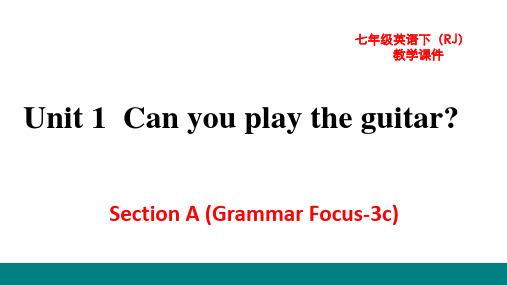
What can you do?
I can dance./I can’t sing.
What club do you want to join? We want to join the chess club.
助动词
实义动词
观察左栏句子,最后一句和前面 的句子有什么不同?
What club do you want to join? 这句话为含有实义动词want的一般现在时的句式结构。
can表“能力”用法 can表示能力时,意为“能;会”。“can+动词原形”表示
“(某人)能/会做某事”,其否定形式为“can’t/cannot+动
词原形”,表示“(某人)不能/不会做某事”。
➢I can play basketball, and my brother can play football. 我会打篮球,我哥哥会踢足球。
否定句
一般疑 问句
He can play the piano. 他会弹钢琴。
主语 + can’t/cannot + 动词原形+其他.
He can’t/cannot play the piano. 他不会弹钢琴。
Can + 主语 + 动词原形 + 其他? 肯定回答:Yes, 主语 + can. 否定回答:No, 主语 + can’t.
Read the poster.
学校(文艺)表演招募学生 show n. 演出;节目 v. 给……看;展示
play sing tell dance
Students Wanted for School Show
We want students for the school show. Can you
人教新目标Go-For-It!(2012)初中英语七年级下册Unit-1-Can-you-play
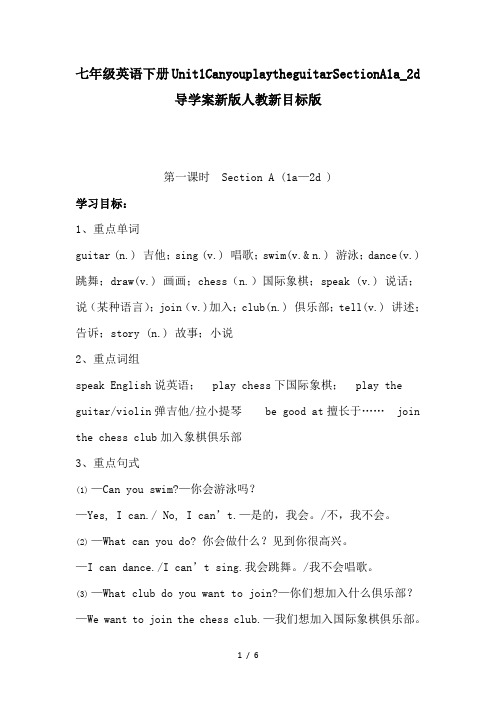
七年级英语下册Unit1CanyouplaytheguitarSectionA1a_2d导学案新版人教新目标版第一课时 Section A (1a—2d )学习目标:1、重点单词guitar (n.) 吉他;sing (v.) 唱歌;swim(v.& n.) 游泳;dance(v.) 跳舞;draw(v.) 画画;chess(n.)国际象棋;speak (v.) 说话;说(某种语言);join(v.)加入;club(n.) 俱乐部;tell(v.) 讲述;告诉;story (n.) 故事;小说2、重点词组speak English说英语; play chess下国际象棋; play the guitar/violin弹吉他/拉小提琴 be good at擅长于…… join the chess club加入象棋俱乐部3、重点句式(1)—Can you swim?—你会游泳吗?—Yes, I can./ No, I can’t.—是的,我会。
/不,我不会。
(2)—What can you do? 你会做什么?见到你很高兴。
—I can dance./I can’t sing.我会跳舞。
/我不会唱歌。
(3)—What club do you want to join?—你们想加入什么俱乐部?—We want to join the chess club.—我们想加入国际象棋俱乐部。
重点难点:(1)掌握动词及动词短语,例如:speak English,play chess,play the piano,be good at, want to do sth.(2) 情态动词can用于询问能力的说法。
导学设计:1.Can you play the guitar? 你会弹吉他吗?【归纳】(1)can是情态动词,意为“”,表示能力,没有人称和数的变化。
can后接,它引导的疑问句常用来询问对方做某事的能力或表示请求。
Unit 2 英语教案人教版新目标七年级英语下册

Unit 2 what time do you go to school?(Section A)教学目标:能够听懂、会说并正确使用日常生活中的时间表达方式。
能够用英语描述自己或他人的日常作息时间。
教学重点:时间表达方式。
熟练使用句型“What time do you...?”和“I usually... at...”。
教学难点:用英语描述自己或他人的日常作息时间。
区分at、in、on的用法。
教学准备:课件、多媒体设备。
钟表、日常生活用品图片等教具。
教学过程:Step 1: Warm-upShow some pictures of daily activities, such as getting up, having breakfast, going to school, doing homework, watching TV, and going to bed.Ask students to describe what they usually do at each time of day.Step 2: PresentationPresent some common time expressions, such as "in the morning", "in the afternoon", "in the evening", "at night", "at 6 o'clock", "at 7:30", and "on Monday".Explain the different uses of "at", "in", and "on".Step 3: PracticeHave students work in pairs to ask and answer questions about each other's daily routines using the sentence pattern "What time do you...?" and "I usually... at...". For example: "What time do you get up? I usually get up at 6:30."Ask some students to share their partners' routines with the class.Step 4: ProductionHave students work in pairs or small groups to create a schedule of their own daily routines.Ask some students to share their schedules with the class.Step 5: Culture CornerShow students a map of the world with different time zones marked on it.Explain how time zones work and the difference between a single time zone country like China and a multi-time zone country like the United States.Step 6: HomeworkAssign students to write a short paragraph about their own daily routines using the sentence pattern "I usually... at...".Encourage students to use the time expressions and sentence patterns they have learned in class.教学反思:本课重点介绍了日常生活中常用的时间表达方式和句型,通过让学生在实践中运用这些表达方式和句型,巩固了他们的学习成果。
(暑期一日一练)2020七年级英语下册 Unit 1 Can you play the guitar Section A备课资料 人教新目标版
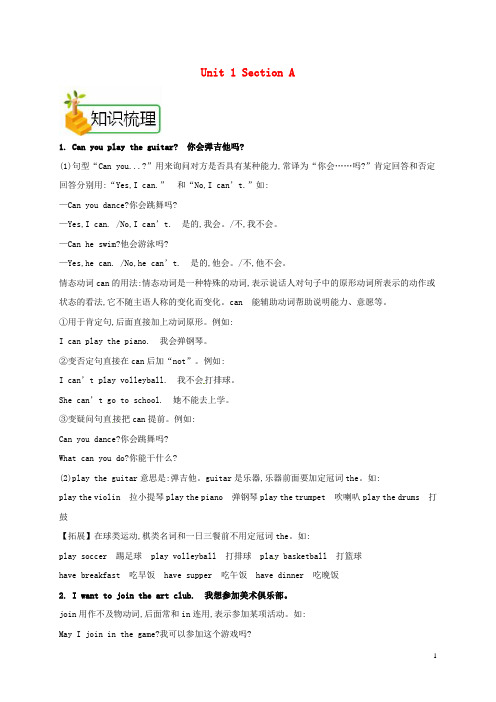
Unit 1 Section A1. Can you play the guitar? 你会弹吉他吗?(1)句型“Can you...?”用来询问对方是否具有某种能力,常译为“你会……吗?”肯定回答和否定回答分别用:“Yes,I can.”和“No,I can’t.”如:—Can you dance?你会跳舞吗?—Yes,I can. /No,I can’t.是的,我会。
/不,我不会。
—Can he swim?他会游泳吗?—Yes,he can. /No,he can’t.是的,他会。
/不,他不会。
情态动词can的用法:情态动词是一种特殊的动词,表示说话人对句子中的原形动词所表示的动作或状态的看法,它不随主语人称的变化而变化。
can 能辅助动词帮助说明能力、意愿等。
①用于肯定句,后面直接加上动词原形。
例如:I can play the piano. 我会弹钢琴。
②变否定句直接在can后加“not”。
例如:I can’t play volleyball.我不会打排球。
She can’t go to school.她不能去上学。
③变疑问句直接把can提前。
例如:Can you dance?你会跳舞吗?What can you do?你能干什么?(2)play the guitar意思是:弹吉他。
guitar是乐器,乐器前面要加定冠词the。
如:play the violin 拉小提琴play the piano 弹钢琴play the trumpet 吹喇叭play the drums 打鼓【拓展】在球类运动,棋类名词和一日三餐前不用定冠词the。
如:play soccer 踢足球play volleyball 打排球pla y basketball 打篮球have breakfast 吃早饭have supper 吃午饭have dinner 吃晚饭2. I want to join the art club. 我想参加美术俱乐部。
Unit1SectionA(1a1c)课件人教版英语七年级下册2
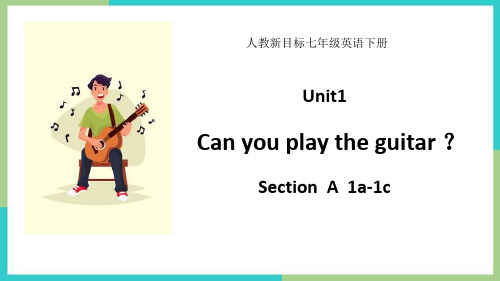
Can .... ?
Can you swim?
Yes, I can. I can swim.
No, I can’t. I can't swim.
Can .... ?
Can you dance?
No, I can't. I can't dance.
Yes, I can. I can dance.
Can you draw?
Yes, I canC.an...? I can draw.
No, I can't. I can't draw.
②B: Can you
swim?
SWIMMING CLUB
① A:I want to join the swimming club.
③A: Yes, I can.
pairwork
A:I want to join the… club . B: Can you …?
speak English
play chess
guitar/ gɪˈtɑː(r) / n.吉他 play the guitar
--What can you do? --I can …
dance
swim
draw
sing
play chess play the guitar speak English
×
2. I want __t_o_j_o_in_ (join) the music club. 3. Let’s __jo_in__ (join) the English club. 4. Alice can’t _s_p_e_a_k_ (speak) Chinese well. 5. Well. You can join the __sw__im__m__in_g_ (swim) club. 6. Jane _w_a_n_t_s_t_o_ (want) to join a sports club. 7. My grandpa __l_ik_e_s_t_o__ (like) play chess. 8. Our Chinese teacher always tell ___s_t_o_ri_e_s (story) to us.
新目标(人教)七年级下册英语教学课件 Unit1 Section A(1a-1c)

dance sing draw swim play chess speak English play the g What can these people do? Match the activities with the
people. 1. sing _e_
Look at the picture and answer the questions.
What can you see in this picture? What clubs can you see?
n. 社团;俱乐部;兴趣小组
Can you Can she Can he
Yes, I can./No, I can’t. Yes, she can./No,she can’t. Yes, he can./No, he can’t.
➢Look! Lily is painting mountains. Jim is drawing a little pig. 看!莉莉正在画山脉,吉姆正在画一头小猪。
2. ①play chess 下国际象棋 ②play the guitar 弹吉他
play作动词的用法
【用法详解】
(1) play与棋牌类或球类名词连用,表示“参加竞技、比赛或球类
A: Yes, I can.
Listen again and answer these questions.
➢ In Conversation 1 What club does the girl want to join? Can she sing? She wants to join the music club. Yes,she can.
play the + 乐器类名词
play the guitar 弹吉他 play the piano 弹钢琴 play the violin 拉小提琴 play the drums 敲鼓
Unit1SectionA1a1c课件人教版七年级英语下册

I can play chess. I want to join the chess club.
I can swim. I want to join the swimming club.
Match the words with the people in the picture.
1. sing__e__
to fill them. 1.A:I want to join the art club. B:Can you draw ?
A:Yes,I can.
2.A:I want to join the chess club . B:Can you play chess ?
A:No,I can’t.
3.A:I want to jointhe English club. B:Can you speak English ? A:Yes, I can .
join in
参加某些活动, I joined in the singing match. 强调一起做某事。我参加了歌唱比赛。
参加会议、婚礼、I will attend her wedding this
attend 典礼、上课、听 Saturday.这个星期六我要参
报告等。
加她的婚礼。
take part in
2. swim__g___
g
3. dance___d__
b
4. draw ___b__
5. play chess__c__
a
6. speak English__a__
e
7. play the
c
f
guitar__f__
Listen and number the conversations [1-3].
新目标七年级英语下册全套教案

新目标英语七年级下册教案Unit1 Where is your pen pal from?Topic:Countries, nationalities, and languagesFunctions:Talk about countries, nationalities and languagesAsk and tell about where people liveStructure:Where's/Where're ...from?Where does/do ...from?What questions----What language does/do ...speak?Target language:Where is she from? She is from....Where does she live? She lives in....What language does she speak? She speaks....Vocabulary:words about countries, languagesTeaching design:The whole unit needs 5 periods, 4 for new lessons and 1 for testPeriod 1 ( 1a----Grammar Focus )Key points:Where is your/John's pen pal from? He/She is from...Where does he/she live? He/She lives in....(Homework for preview)Pre-task:Let the Ss give themselves pen pals and they should write down their pen pals' information, such as their names, countries and cities they live even the language they speak.T can give the Ss an example meanwhile T gives the different countries which can be used by the Ss. T gives the Ss Chinese words for the countries, they are following: 加拿大,法国,日本,美国,澳大利亚,新加坡,英国,中国( The Ss can look them up in the dictionary if they are new for them)The example is following:Name: Curry MurayAge: 75From(Nationality): the United StatesCity: New YorkLanguage: EnglishTeaching Steps:Key points:Where is your/John's pen pal from? He/She is from...Where does he/she live? He/She lives in....(Homework for preview)Pre-task:Let the Ss give themselves pen pals and they should write down their pen pals' information, such as their names, countries and cities they live even the language they speakT can give the Ss an example meanwhile T gives the different countries which can be used by the Ss. T gives the Ss Chinese words for the countries, they are following: 加拿大,法国,日本,美国,澳大利亚,新加坡,英国,中国( The Ss can look them up in the dictionary if they are new for them)The example is following:Name: Curry MurayAge: 75From(Nationality): the United StatesCity: New YorkLanguage: EnglishTeaching Steps:Step 1 Leading-inThe information of the teacher's own pen pal's information."I have a pen pal. His name is Curry Muray. He is from the United States. Do you have a pen pal? Where is your pen pal from? What's your pen pal's name?"Different students say the information about their own pen pals. T should choose the different countries. T writes the different countries on the Bb(both Chinese and English)Step 2 LearningSection A 1a Learn the new words on the Bb. The new words are: pen pal; Canada; France; Japan; the United States(the US/theUSA/America); Australia; Singapore; the United Kingdom(theU.K./Great Britain/England)Pay attention to the pronuciation of the new words.Step 3 Listening1b Listen and circle the countries in 1a they learnedStep 4 CompetitionTwo groups of students to write the new words to see which group does better. First write down the Chinese words with looking at theEnglish meanings, then write down the English words with looking at the Chinese meanings.(This step is a memory game. It can help the Ss consolidate the new words they learned)Step 5Pairwork1c Practise the following conversation:---Do you have a pen pal? ---Yes, I do.---Where's your pen pal's from? ----He/She is from ....(Write it down on the Bb)First T has a conversation with one student as an example then let the Ss practise in pairs. At last let several pairs do it again in class.Step 6Leading-inRevise the countries names with looking at the Bb. Then T writes down the city names on the Bb. Let the Ss try to find out which countries the cities are in. The city names are following:Toronto; Paris; Tokyo; New York; Sydney; Singapore; London;Step 7 Learning2a Learn the city names together with the whole class just like Step 22b Listen and circle the cities and countries2c Listen and complete the chartHave a similar competition to consolidate the new words in this part.Step 8PairworkT has a conversation with one student like the following:---Do you have a pen pal? ---Yes, I do.---What's your pen pal's name? ---His/Her name is....---Where is your pen pal from? ---He/She is from...---Where does he/she live? ---He/She lives in....(Write it down on the Bb)Let the Ss practise after the T's example in pairs then several pairs do it in class.Step 9ExerciseMy pen pal is from Australia.(划线提问)John's pen pal is from Japan. (划线提问)He lives in Paris. (划线提问)Homework:Read and copy the new words .Copy the sentences in Grammar FocusMake up the questions about Jodie in 2c The questions are:Does Jodie have a pen pal? Where is Jodie's pen pal from? Where does he/she live? What's his/her name?(This one can be chosen by themselves)Unit 2 Where's the post office?Language goalThis unit students leam to ask for and give directions(方向) on the street.New languageIs there a bank near here? Y es, there's a bank on Center Street, Where's the supermarket? It's next to the library.Is there a pay phone in the neighbhood?Y es, it's on Bridge Street on the right.locations in the neighborhood such as post office, hotel,video arcade. Descriptive words such as new, old, dirty, clean.Descriptions of location such as across from, next to,BetweenRecycled languageWhat are you doing?Do you want to ...?Section AAsk two rows of three students each to stand facing each other in the front of the classroom. Point to students standing in front and ask the class to repeat the questions and answers.Example 1Teacher: Where'sY ang Li? (Point to two students standing beside each other.) Y ang Li is next to Li Peng.Example 2Teacher: Where's Zheng Wen? (Point to two students in different lines facing each other.)Zheng Wen is across from Sheng Lin. Example 3Teacher: Where's Lin Jiahui? (Point to one student standing betweentwo other students.) Lin Jiahui is between Sheng Lin and Li Dai.la This activity introduces the key vocabulary.Focus attention on the picture. Ask students to name as many of the places they see in the picture as they can.Then name all the places and ask students to repeat.Point out the numbered list of words. Say each one and ask students to repeat.Then ask students to match each word or phrase on the list with one of the pictures. Say, Write the letter of each place in the picture next to the correct word or words on the list. Point out the sample answer f.Check the answers.1b This activity gives students practice listening to and understanding the target language.Point out the buildings and other locations in the picture. Say the name of each one to the class.Say, Now I will play recordings of three conversations. Listen carefully and circle the picture of each place you hear on the tape..Play the recording the first time. Students only listen.Play the recording a second time. This tine ask students to listen and circle the items they hear on the picture.Correct the answers.These items should be circle:video arcade, post office, supermarket.Tapescript(录音稿)Convernation 1A: Is there a video arcade on Fifth Avenue?B: Yes, there is.Conversation 2A: Is there a post office near here?B: Yes, there is. There's one on Bridge Street.Conversation 3A: Is there a supermarket on Center Street?B: No, there isn't.1C This activity provides guided oral practice using the target language.Point to the different locations shown in the picture.Ask different students to name each one. If necessary,say the name and ask the student to repeat.Point to the question and answer In the example conversation and ask a pair of students to read the conversation to the class.Ask other pairs of students to repeat the activity if you wish.Ask students to work in pairs. Say, First one person asks a question and then the other person takes a turn.Demonstrate(示范)the activity. Point to the picture and ask. Is there a post office near here? Then choose a student to answer. Guide the student to say, Y es,there's a post office on Bridge Street. As students work, move around the room and check progress(进展情况). Help students understand how to locate things on the map, if necessary.Ask several students to say some of their questions and answers for the class.教学后记:教学方法有问题?教了这么多年的英语,总幻想有一种方法,能让学生轻轻松松把英语学好。
人教版新目标初中英语七年级下册全套教案

Unit 1 Where’s your pen pal from?一、单元教材分析本单元的中心话题是pen pals。
主要语言功能项目是talk about countries, cities and languages。
语法结构为Where…from; Where…live and what language…speak。
先以Activity1复习语言与国家的配对练习入手,Activity2a, 2b一个综合的听力训练来展示学生的听力能力,并以听力内容为基础,通过Activity2c中假设的两人对话操练来培养学生的交流能力,同时也引导学生多沟通与多交流。
Activity3a是一篇email形式的阅读文章,并有相关问题由学生在阅读后进行回答Activity3b 是根据提供的信息进行填空的写作练习,Activity3c 是一篇模仿写作,让学生给自己的笔友写一封关于本人信息的email。
我在各课时教学中设计各种各样的小活动,通过Discussion,Classifying,Guessing等不同方式让学生掌握本单元的知识点,用学会的知识与外国的笔友自如的交谈是学习本单元的目的。
二、教学目标分析1、语言目标a. 重点词汇:Countries: Canada, China, France, Japan, the United States, Singapore, Australia,The United Kingdom, Paris.Cities: Sydney, New York, Toronto, Toyo, LondonLanguages: English, French, Japanese, Chinese.b. 重点句型:-Where…from? -She’s/He’s from…-Where does…live? -She/He lives in …-What language does she /he speak? -She/He speaks ….2、能力目标a. 培养学生在文段中寻找信息的能力;b. 学会用英文给笔友写回信,简单介绍个人情况;c. 通过有效地小组合作,培养学生合作能力及团队精神。
英语人教新目标七年级下册七下Unit 1Section B 2a-2c
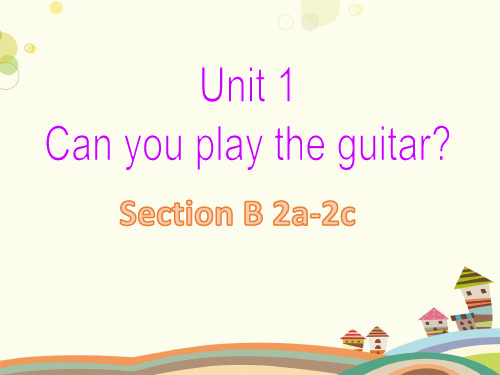
2. To read the ads to get the main idea. 3. To learn to write a poster. 4. To learn the words and phrases: 1) also, people, help (sb) with sth, center, home,
1.Where do they need help? At the old people's home.
2. When do they need help ?
In July
3. What do you need to do? To talk with the old people and play games with them.
Sentences: I can play ping-pong and chess. I can speak English and I can also play soccer.
Ⅰ. 根据语境,从方框中选择恰当的单词填 空,有的需要变换形式。
drum, people, musician, center, weekend
……有办法 make friends 交朋友 need sb. to do sth. 需要某人做某事 help (sb.) with sth. 在某方面帮助(某人)
Students’ Sports 学生体育活动中心 Center
on the weekend 在周末 music festival 音乐节
what when where how
Read the ads again and complete the blanks.
Unit1SectionA(GrammarFocus3c)课件初中英语人教版新目标七年级下册
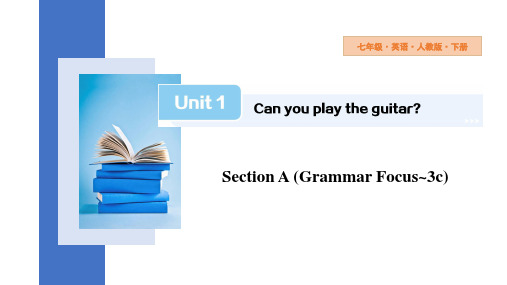
合作探究
学习情态动词can ◎学法指导:完成3a时,注意多观察教材所给的例句。可以 与同伴多交流。
1.阅读下列一段话,与同伴交流,回答问题。 I can sing and dance. But I can’t draw. I can swim,and I swim very well. Can you play chess? I can play chess. My brother can play chess, too. We often play chess together ( 一 起 ). Can he play the piano? Yes, he can. He can also play the guitar. He likes music.
★can后应用什么形式?_动__词__原__形__
★can会随人称变化而变化吗?_不__会____
★can的否定句是怎么变化的?__在__c_a_n_后__加__n_o_t___
★含有can的肯定句变成疑问句需要借助助动词吗?应如何 把含can的肯定句变为一般疑问句?
不__需__要__,_只__要__把__c_a_n_提__前__到__句__首__即__变__成__了__一__般__疑__问__句__。_____
(4)Jane和Jill会游泳吗?是的,她们会。/ 不,她们不会。 _C_a_n__J_a_n_e__a_n_d__J_i_l_l__s_w_i_m_?__Y_e_s_,__t_h_e_y__c_a_n_._/_N_o_,_t_h_e_y___ _c_a_n_’__t.
(5)你会做什么? 我会跳舞。 _W_h_a_t__c_a_n__y_o_u__d_o_?_I__c_a_n__d_a_n_c_e_.__
Unit1SectionA(2a2d)课件人教版英语七年级下册(5)
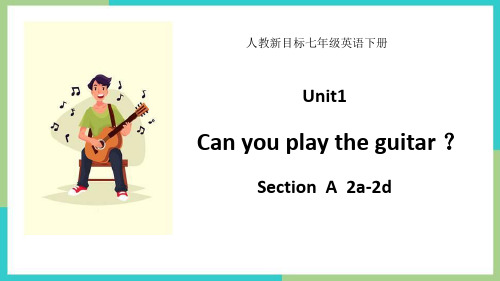
1.What club do you want to join?你想加入什么俱乐部? “what+名词”引导特殊疑问句的用法 what和一些名词搭配可以用来对多种情况提问: what color用来询问颜色;what time用来询问时间;what size用来询问尺寸;what kind用来询问种类。 —What color is the jacket?这件夹克衫是什么颜色的?
Exercise 根据括号内所给词的适当形式填空。
1. He can _sw__im___. And he is good at _s_w_i_m_m__in_g_. So he wants to join the _s_w_i_m_m__in_g__ club.(swim)
2. I can’t _d_a_n_c_e_ well. But I am interested in d_a_n_c_i_n_g. So can I join the _d_a_n_c_in_g__ club? (dance)
swim
swimming club
I can swim. I want to join the swimming club.
Look at 2b and talk about what the people can do and the clubs they want to join.
Use these information Lisa chess can’t play chess Bob English likes English Mary and Bob music like music Mary can sing and dance
考点拓展 (1)what意为“什么”,单独使用时用来询问某 物是什么,回答用“It's a/an+名词单数.”。 —What's this?这是什么? —It's a map of China.它是一张中国地图。 (2) 若要询问某些事物是什么,可以用“What are these/those?”,回答用“They're+名词复 数.”。 —What are these?这些是什么? —They are pens.它们是钢笔。
新目标英语_2012年新版 七年级下册 unit 1 Can you play the guitar 单元教案(全课时)

Tape recorder; Multi-Media.PPT
附课件
教学过程
设计意图
Step One .Step1Warming-up
In this procedure, ask students what clubs are there in their class, what club they want to join and about their abilities.
Encourage the students to say something about the picture and do the match work.
T: What can people do in picture a?
S: They can dance.
T: Write “a” on the line next to the word “dance”. Clear?
Play the recorder. Then check the answers.
After this, ask students to repeat after the recording.
Step Four:Pairwork (1c)
Ask students to practice the conversation and make their own conversations.
Help students learn how to listen to and talk about what club they want to join.
重点
How to listen to and talk about what club they want to join.
人教版(新目标)初中英语七年级下册Unit 2
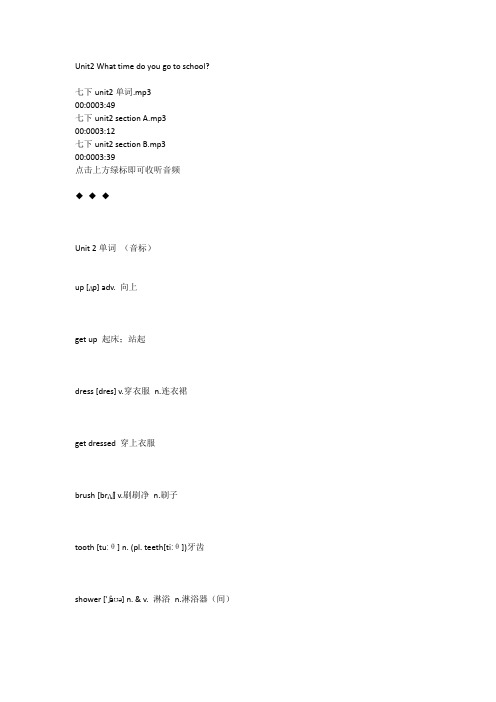
Unit2 What time do you go to school?七下unit2单词.mp300:0003:49七下unit2 section A.mp300:0003:12七下unit2 section B.mp300:0003:39点击上方绿标即可收听音频◆◆◆Unit 2单词(音标)up [ʌp] adv. 向上get up 起床;站起dress [dres] v.穿衣服n.连衣裙get dressed 穿上衣服brush [brʌʃ] v.刷刷净n.刷子tooth [tuːθ] n. (pl. teeth[tiːθ])牙齿shower ['ʃaʊə] n. & v. 淋浴n.淋浴器(间)take a shower 洗淋浴usually ['ju:ʒuəli] adv.通常地;一般地forty ['fɔ:(r)ti] num.四十wow [waʊ] interj.(表示惊奇或敬佩)哇;呀never ['nevə(r)] adv.从不;绝不early ['ɜːlɪ] adv. & adj.早(的)fifty ['fɪftɪ] num.五十job [dʒɒb], [dʒɑːb] n.工作;职业work [wɜːk] v. & n. 工作station ['steɪʃn] n.电(视)台;车站radio station 广播电台o'clock [ə'klɒk], [ə'klɑ:k] adv.(表示整点)……点钟night [naɪt] n. 晚上;夜晚funny ['fʌnɪ] adj.奇怪的;滑稽好笑的exercise ['eksəsaɪz] v. & n. 锻炼;练习on weekends (在)周末best [best] adj.最好的adv.最好地;最group [gruːp] n.组;群half [hɑːf], [hæf] n. & pron. 一半;半数past [pɑːst],[pæst] prep.晚于;过(时间)adj.过去的quarter ['kwɔː(r)tə(r)] n.一刻钟;四分之一homework['həʊmwɜː(r)k] n. 家庭作业do (one’s) homework 做作业run [rʌn] v. 跑;奔clean [kliːn] v.打扫;弄干净adj.干净的walk [wɔːk] n. & v. 行走;步行take a walk 散步;走一走quickly ['kwɪkli] adv. 很快地either ['aɪðə(r)], [ 'iːðə(r) ]adv.或者;也(用在否定词组后)either…or…要么……要么……;或者……或者……lot [lɒt], [lɑ:t] pron.大量;许多lots of 大量;许多sometimes ['sʌmtaɪmz] adv.有时taste [teɪst] v.有……的味道;品尝n.味道;滋味life [laɪf] n.生活;生命Rick [rɪk] 里克(男名)Jim [dʒɪm] 吉姆(男名)Scott [skɒt], [skɑ:t] 斯科特(男名)Tony ['təʊnɪ] 托尼(男名)unit2电子课本Unit2 知识梳理◆短语归纳1. what time 几点2. go to school 去上学3. get up 起床4. take a shower 洗淋浴5. brush teeth 刷牙6. get to 到达7. do homework 做家庭作业8. go to work 去上班9. go home 回家10. eat breakfast 吃早饭11. get dressed 穿上衣服12. get home 到家13. either…or…要么…要么…14. go to bed 上床睡觉15. in the morning/afternoon/evening 在上午/下午/晚上16. take a walk 散步17. lots of=a lot of 许多,大量18. radio station 广播电台19. at night 在晚上20. be late for=arrive late for 迟到◆用法集萃1. at + 具体时间点在几点(几分)2. eat breakfast/lunch/dinner 吃早饭/午饭/晚饭3. thirty/half past +基数词…点半4. fifteen/a quarter to +基数词差一刻到…点5. take a/an+名词从事…活动6. from…to…从…到…7. need to do sth 需要做某事◆典句必背1. —What time do you usually get up? 你通常几点钟起床?—I usually get up at six thirty. 我通常6:30起床。
Unit 1 同步练习 2021-2022学年人教新目标(Go for it)版英语七年级下册

Unit 1 Can you play the guitar?Section A Grammar Focus-3cⅡ.根据汉语意思完成句子。
1. 简会弹钢琴, 但她不会拉小提琴。
Jane ________ play basketball, ________ she ________ play volleyball.2. 我们需要能参加学校节目演出的学生。
We need________ ________ ________ ________ ________.3.你会唱歌还是会跳舞?________ you sing ________ dance?4. 请放学以后咱们谈谈。
Let’s ________ after class.5.来给我们演示一下!________ and ________ ________ !6.汤姆会中国功夫。
Tom can ________ ________ ________ ________.7.我们通常在放学后打篮球。
They usually ________ ________ after school.8.凯特能够为班级表演弹吉他。
Kate can ________ ________ ________ for the class show.9.鲍勃的哥哥不会游泳和下国际象棋。
Bob’s brother ________ swim ________ play chess.10.这位作家擅长写故事。
The writer is good at _________ _________ .Ⅲ.单项选择题。
1.The little boy ________ write many English words though (尽管) he is only 3 years old.A.mustB. needC. canD. may2.Please don't talk ________ your mother like that. It’s not polite(礼貌).A. toB. inC. ofD. for3. Let’s talk ________ your brother’s study ________ him after school.A. about; withB. for; aboutC. about; forD. with; for4.I have two books. Which one do you like better, the blue one ________ the green one?A. butB. andC. orD. with5. —Which color do you like better, green or red?—________, because I like our national flag(国旗).A.Yes, I doB. No, I don'tC. GreenD. Red6.Jim likes playing chess. He wants ________ a chess club.A.to joinB. joinsC. joiningD. join7.—Does she like singing ________ dancing?—She likes singing.A.andB. orC. butD. so8.—________?—The violin club.A. What color do you likeB. What club do you want to joinC. What can you doD. What's your favorite subject Ⅳ.按要求完成下列句子, 每空一词。
Unit 1 Section A测试题 七年级下学期英语人教新目标(含答案)

Unit 1 Can you play the guitar?Section A (1a-2d) 练习一.翻译词组(中英互译)1.下象棋_____________2. play the guitar______________3.加入艺术俱乐部_________________4. speak English well___________5.体育俱乐部__________________6. sound good__________________7.象棋俱乐部__________________8. swimming club_______________9.英语俱乐部____________ 10.音乐俱乐部________________ 11.某人想做某事_________________ 12.擅长于做某事______________13.讲故事_________________ 14. 踢足球______________二.单项选择( ) 1. My brother wants _______ the swimming club.A. to joinB. joinsC. joiningD. join( ) 2. —_________ Lisa speak Chinese?—No, she _________.A. Do, don’tB. Is, isn’tC. Does, can’tD. Ca n can’t ( ) 3. —Can your sister sing?—_________.A.Yes, he canB. Yes, he doesC. No, she doesn’tD. Yes, she can( ) 4. Mike can play ________ basketball, but he can’t play _______ violin.A. the; theB./;/C. the;/D./;the( ) 5.—Can you paint or sing?—_______.A. Yes, I canB. No, I can’tC. I can singD. I like singing ( ) 6.—Tom likes soccer. What club can he join?—He can join the ______ club.A. sportB. musicC. sportsD. swimming( )7– Can you play ____ chess?– Yes, I canA .a B. an C .the D./( )8.Little Tom can draw ________. Hi s drawings are very ________.A good wellB well goodC good goodD well well( )9.—Can you ____ Japanese?—A little.A speakB sayC talkD tell( )10. Can he dance? Yes, he ________.A doB canC isD can’t三.用所给词的适当形式填空1. Do you want to join the ___________ (swim) club?2. Can Mary and Alice ___________ (play) computer games?3. Come and ______________(join) the art club.4. She wants _____________ (dance) with her friends.5. Thanks for _________________ (help) me6.what club do you want___________(join)?7.Bob_____________(like) English club, so he joins it.8.My good friends ___________(speak) English very well.9.What club does Tom ___________(want ) to join?10.Can you ___________(swim).四.句型转换1. She can play the piano . (改为一般疑问句)________ ________ play the piano?2. Can you and Paul play computer games? (肯定答语)Yes, _________ _________.3. Lisa can swim and sing. (改为否定句)Lisa ________ swim ________ sing.4. David can play the violin, too. (改为同义句)David ________ ________ play the violin.5. The boy can dance. (对划线部分提问)________ can the boy ________?五. 完形填空Hello, I’m Abel. We have some 1 in our school — the music club, the chess club, the sports club and so on. Many boys want to 2 the sports club. What sports can 3 play? They can play basketball, volleyball and tennis, and they 4 basketball best. They think it’s interesting and 5 . We all know Lin Shuhao is 6 great basketball player. Boys 7 to be a basketball player like him. Some girls 8 like playing basketball.Can y ou play basketball? If not, I can tell you how. I’m9 the basketball club. I can play it well. It’s not 10 to be a good player. But if you work hard and often play it, you can do well.( )1. A. classes B. clubs C. computers D. subjects( )2. A. see B. help C. join D. sell( )3. A. they B. we C. you D. he( )4. A. thank B. need C. watch D. love( )5. A. boring B. fun C. busy D. free( )6. A. the B. an C. a D. 不填( )7. A. sound B. want C. get D. come( )8. A. also B. too C. only D. very( )9. A. at B. with C. in D. on( )10. A. small B. difficult C. big D. easy参考答案一.翻译词组(中英互译)1. play chess2. 弹吉他3. join art club4. 英语说得好5. sports club6. 听起来很好7. chess club 8. 游泳俱乐部9. English club10. music club 11. sb. want to do sth. 12. be good at doing sth.13. tell stories 14. play soccer二.单项选择1-5 A D D D C6-10 C D B A B三.用所给词的适当形式填空1. swimming2. play3. join4. to dance5. helping6. to join7. likes 8. speak 9. want10. swim四.句型转换1. Can she2. We can3. can’t or4. also can5. What do五. 完形填空1-5 B C A D B6-10 C B A C DUnit1 Can you play the guitar ?Section A (2a-3c) 练习一.单项选择( ) 1. —Can Amy play ________ chess?—Yes. And she can play ________ guitar, too.A. a; theB. the; theC. the; /D. / ; the ( ) 2. —Mike, what’s your favorite subject, math ________ science?—Math.A. andB. orC. butD. so( ) 3. —Can you sing this song?—________. It’s difficult for me.A. Yes, I doB. Yes, I canC. No, I can’tD. Yes, I can’t ( ) 4. —________?—He can do kung fu.A.What does Eric likeB. Can Eric do kung fuC. What can Eric doD. What can Eric like( ) 5.My brother Peter is good at ______ model planes.A. makeB. makesC. makingD. to make ( ) 6. Miss Li is from China, so she ______ Chinese well.A. tellsB. speaksC. talksD. say( )7. Can he ________ it in English?A.speak B.tell C.say D. talk ( ) 8. I want to with you.A.speak B.tell C.say D. talk ( )9.My father often me stories.A. tellsB. speaksC. talksD. say( )10.Cindy c an’t ______ basketball, but she ______ volleyball well.A. play; playsB. plays; playsC. play; play( ) 11.She can dance. I can dance, .A. alsoB. toC. tooD. either( ) 12. —_________club does B ill’s cousin join?—English club.A. HowB. WhatC. WhenD. where( ) 13. He can play the guitar__________he can’t play it very well.A. orB. andC. but D also( ) 14. Do you like apples_______bananas?A. butB. orC. so D because( ) 15.Miss Read is good ________ music.A.at B.with C.about D.for( ) 16. Hi, can I help you? ________.A.Yes, please B.No, I can’t C.Yes, I can D.You are welcome ( ) 17.Little Tom is a _____ singer. He can sing very ________.A.good, well B.well, good C.good, good D.well, well 二.用所给词的适当形式填空1. Ms. Brown ________ (speak) English well. We all like her.2. Paul ____________ (swim) for an hour every day.3. What’s the price of the two ________(piano)?4. Sally can ________ (write) her name.5.What about (play) basketball ?6.She wants (join) the chess club.7.Let’s (go) home.8.Let’s join the (swim) club9.She likes (sing).三.完成句子1.你会跳舞吗? 是的,我会._________________________________________________________2. 我会弹吉他。
- 1、下载文档前请自行甄别文档内容的完整性,平台不提供额外的编辑、内容补充、找答案等附加服务。
- 2、"仅部分预览"的文档,不可在线预览部分如存在完整性等问题,可反馈申请退款(可完整预览的文档不适用该条件!)。
- 3、如文档侵犯您的权益,请联系客服反馈,我们会尽快为您处理(人工客服工作时间:9:00-18:30)。
Unit 1.Where’s your pen pal from?
Introduce your pen pal to us :
A:What’s your pen pal’s name? B:His name is …
A: Where is he from?
B:He…
A:Where does he live?
What languages do they speak?
What language do Chinese speak?
China
Chinese
What language do Canadian speak?
Canada
English and French
What language do Frenchmen speak?
国籍
形容词
语言
国人
国人的复数
China
Japan
France
Chinese
Chinese Chinese
Chinese
Japanese
Frenchmen
Japanese Japanese Japanese
French French Frenchman
Frenchwoman
Frenchwomen
England English
A:What’s your pen pal’s name? B:Her name is … Introduce your pen pal to us : A: Where is she from? B:She is… A:Where does she live? B: She lives in … A:What language does she speak? B:She speaks…
languages.
虽然他很小, 但他会说七门语言。
12. speak English 说英语 如: Can you speak Chinese?
你会讲汉语吗? 例题: Tom can ____ Japanese. B A. speaks B. speak C. says D. tell say 强调说话的内容,say it in English
3b. Pairwork
What language
does she speak?
This is my new pen pal. She’s from Australia.
She speaks English.
Have a try
1. Chinese come from China. They speak Chinese. come from Japan speak Japanese 2. Japanese ________________. They _______________. come from UK speak English 3. Englishmen _______________.They _______________. come from France speak French 4. Frenchmen ________________. They ______________. come from America speak English 5. Americans __________________.They _____________. 6. Australians __________________. They _____________. come from Australia speak English Cantonese 7.People in Dong Guan speak____________
3. I have a pen pal in Japan.(对划线部分提问) Who has a pen pal in Japan? 4. Jim speaks English.(对划线部分提问) What does Jim speak? 5. She wants to join the music club. (对划线部分提问) What does she want to do?
Ⅲ.句型转换
1. Simon is from Canada.(对划线部分提问) Where is Simon from?
2. I like going to the movie with my friends. (对划线部分提问)
What do you like doing with your friends?
Australia
English
What language do Singaporean speak?
Singapore
English and Chinese
What language do English speak?
The United Kingdom
English
3a.What language do they speak?
8. Sydney 悉尼(澳大利亚第一大城市)
注意:澳大利亚首都是堪培拉(Canberra)
New York 纽约(美国著名城市)
注意: 美国首都是华盛顿(Washington D.C) Paris 巴黎, 法国首都。 Toronto 多伦多(加拿大著名城市)。 注意: 加拿大首都是渥太华(Ottawa)。
A. Do
B. Are
C. How
B 3. I am from China.What _____ you? A. like B. about C. of
4. —Is he from America? C —____________. A. Yes,he does B. No, he doesn’t C. Yes, he is.
Chinese walls 严格保密,万无一失
American dream 人人自由,机会均等 Take French leave 不辞而别 Go Dutch(荷兰) AA制 4. 注意国籍词在同义句转换中的运用。 如: I come from America. =I am from America. =I am American. =I am an
“speak + 某语言”意为“讲„„语言”
Ⅰ. Match the cities with the countries and languages.
Capital Country
Language
English
New York
Canberra Tokyo Paris Beijing Brasilia
B: He lives in …
A:What’s your pen pal’s name? B:Her name is … A: Where is she from? B:She is… A:Where does she live? B: She lives in …
Introduce your pen pal to us :
Tokyo 东京,日本首都。
9. live 居住, 实义动词, 居住在某地 常用“live in + 地点(国家/城市)”。如: --Where does he live? --He lives in Paris. 10. language “语言”, 可数名词。如:
He is young, but he can speak seven
Australia
America
Chinese
Japanese
Brazil
China
French
Portuguese
France
Japan
Ⅱ. 单项选择
1. _______ Mary from? C
A.What's
B.Where
C.Where's
A 2. _______ you speak English or Spanish?
=She comes from France.
be from的主语如果是物, 可指“此物
产于何地”。 如:--Where is your computer from? --It’s from Beijing.
7. city 城市
复数:three cities 三座城市
He’s from a big city. 他来自一个大城市。
American. 我是美国人。
5. be from “来自”。如:
I am from Japan. 我来自日本。
Where are you from? 你来自什么地方? Where is John from? 约翰来自什么地方? be from = come from 来自 如: She is from France. 她来自法国。
English
Englishman
Englishmen
Englishwomen
Englishwoman
国籍 America
形容词 American
语言 English English French
国人 American
国人的复数 Americans
Canada
Canadian
Canadian
Canadians
A:What’s your pen pal’s name?
B:His name is …
Introduce your pen pal to us :
A: Where is he from?
B:He… A:Where does he live? B: He lives in … A:What language does he speak? B:He…
Singapore Australia
the United States
China
